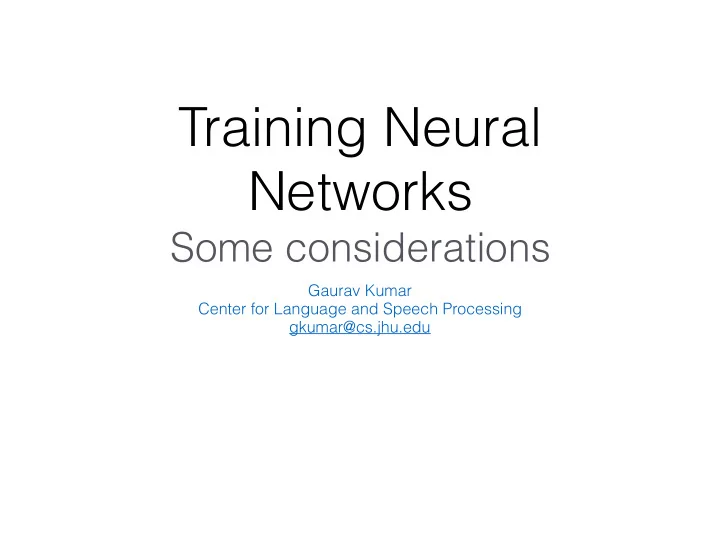

Training Neural Networks Some considerations Gaurav Kumar Center for Language and Speech Processing gkumar@cs.jhu.edu
Universal Approximators • Neural networks can approximate [1] function. any • Capacity • Layers • hidden layer size • A bsence of regularization • Optimal activation functions and hyper-parameters. • Training data [1] K. Hornik, M. Stinchcombe, and H. White. 1989. Multilayer feedforward networks are universal approximators. Neural Netw. 2, 5 (July 1989) : proved this for a specific class of functions.
Universal Approximators • We will focus on two important aspects of training: • Ideal properties of parameters during training • Generalization error • Other things to consider: • Hyper-parameter optimization • Choice of model, loss functions • Learning rates (Use Adadelta or Adam) • …
Properties of Parameters • Responsive to activation functions • Numerically stable
Activation Saturation Sigmoid Relu
Initialization of weight matrices • Are you using a non-recurrent NN ? • Use the Xavier initialization • (use small values to initialize bias vectors) Glorot & Bengio (2010), He et.al (2015)
Initialization of weight matrices (Xavier, He) • Tanh • Sigmoid • Relu
Initialization of weight matrices • Are you using a recurrent NN ? • With LSTMs : Use the Saxe initialization • All weight matrices initialized to be orthonormal (Gaussian noise -> SVD) • Without LSTMS • All weight matrices initialized to identity Saxe et al, 2014,
Watch your input • A high variance in input features may cause saturation very early • Mean subtraction : Same mean across all features • Normalization : Same scale across all features
Numerical stability • Floating point precision causes values to overflow or underflow • Instead, compute
Numerical stability L = − t log( p ) − (1 − t )log(1 − p ) • Cross Entropy Loss • Probabilities close to 0 for the correct label will cause underflow • Use range clipping. All values between 0.000001 and 0.999999.
Generalization Preventing Overfitting
Regularization • L2 regularization • L1 regularization • Gradient clipping (max norm constraints)
Regularization • Perform layer-wise regularization • After computing the activated value of each layer, normalize with the L2 norm. • No regularization hyper-parameters • No waiting till back-propagation for weight penalties to flow in
Dropout Nitish Srivastava, Geoffrey Hinton, Alex Krizhevsky, Ilya Sutskever, and Ruslan Salakhutdinov. 2014. Dropout: a simple way to prevent neural networks from overfitting. J. Mach. Learn. Res. 15
Dropout
Dropout • Interpret as regularization • Interpret as training an ensemble of thinned networks
Recommend
More recommend